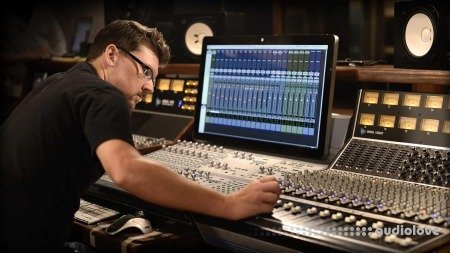Pro Studio Live Active Rock Metal Recording Session Day 1 of 2 [TUTORiAL]

FANTASTiC | 21 February 2020 | 7.82 GB
In this engaging and informative episode, Chris Baseford brings us through a day of tracking with band QUOR. You’ll learn how Chris got started with audio engineering, what he does for pre-production, and what he does leading up to a tracking session. He’ll cover his drum and guitar tracking setup in detail, including how and why he chose the setup he chose for this episode. You’ll hear how he starts setups like these, how and why he will choose to adjust the setup, and other tips about his process. This includes details like why he uses 3 overhead mics on drums, his process for when and how much compression to use for the tracking process, and some tips and tricks for comping and editing. Chris demonstrates and discusses the philosophy of many interesting topics in this episode, including elastic audio vs beat detective, mic positioning for guitar cabs, and some frequency balance tips for guitars. You’ll also learn organizational tips that will help you become more efficient as an engineer, including a full explanation of how he takes notes during tracking. This episode is great for anyone that’s interested in learning a bit more about the production and tracking process, so check it out!
In this episode:
home page
In this episode:
- How Chris got started
- His approach to pre-production
- How the way we mix and work with music (specifically the frequency spectrum) reflects the changes in the average music playback system
- What he did leading up to the setup we see during the episode
- Overview of a good rock drums mic setup
- The importance of room mics
- Some things to consider regarding closed mics vs not
- Effects mics
- Chris’ preference for drum tuning
- The importance of listening for what it sounds like in the control room and not just what things sound like in the live room
- Chris mentions what he does that’s very basic, and what’s more unusual, so you can get a sense of what are his personal tricks, vs fairly industry standard stuff
- Using the proximity effect to your advantage while miking drums
- Why he does 3 overhead mics, and basics of how he will mix them
- How and why he chose his room mics (and their locations) for this session
- Information on different mic configurations, including mid side
- What he does with the signal from each microphone: including compression, EQ, phasing, etc
- Using compression for controlling levels, and for shaping transients and giving it a sonic character
- Tools and methods for adjusting phasing
- How pres influence his decisions, and other questions from our audience
- Details on what Chris writes down for notes during tracking, and why
- Compensating for dynamics and other differences between takes
- Why he does longer passes for each take
- How and why Chris takes samples from his drummer during a tracking session
- Comping drum takes
- Editing drums: how to even out the sound, smooth over edit points, nudging to smooth edits, smoothing transitions, adjusting timing
- The importance of a fresh ear
- Chris’ advice on working with a grid, and his opinion on beat detective vs elastic audio
- Guitar setup: what he usually starts out with, and some philosophy on miking guitar cabs
- How to make a big change in your sound by slightly shifting your microphones
- Tips for getting a stereo spread in your guitar sound
- How to tell if something is helping your sound or not
- Frequency balance tips for guitar - getting it clean while still keeping it heavy and full
- Chris’ philosophy amp modelling vs the real thing
- How Chris uses reference tracks
home page
Only registered users can see Download Links. Please or login.


No comments yet